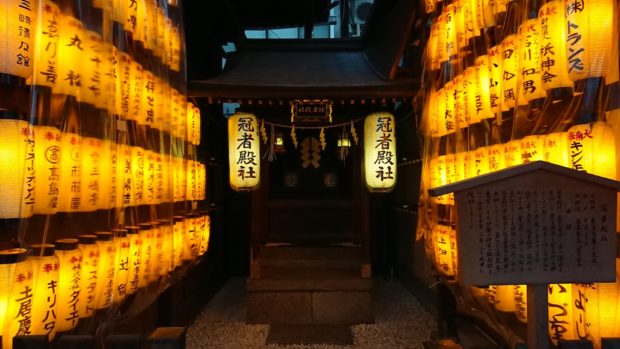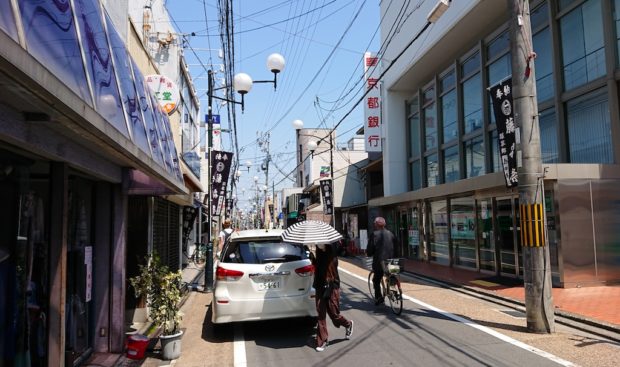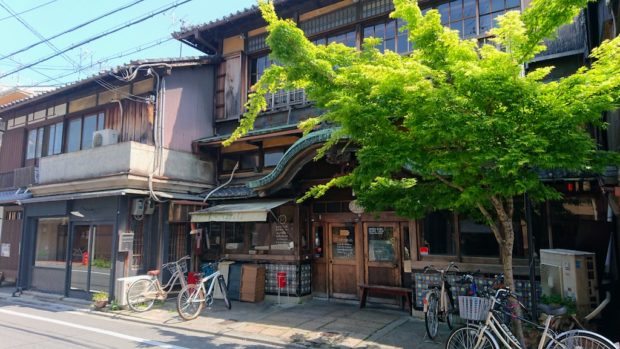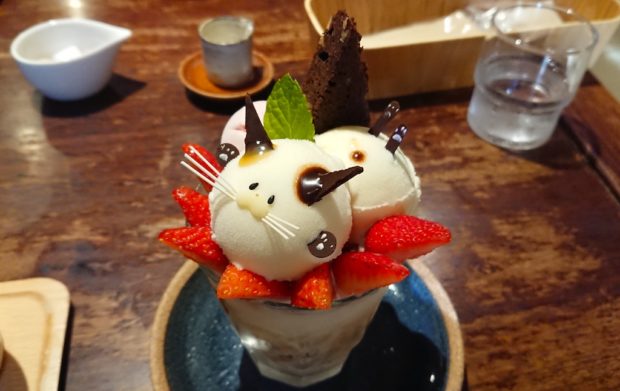You have no items in your cart. Want to get some nice things?
Go shopping
Start from part one of this series.
The Land of the Rising Sun is also the Land of Many Faces. It’s not just a case of new Japan (neon lights, manga mascots) doing star-jumps while the old Japan (paper lanterns, temples) peers from behind the door. That’s evident through all but the most rural of towns. There’s also logical, straight Japan with its suit and calculator, efficient to the point of superhuman. To which there is the counterpoint: wacky Japan, its pants outside its trousers and lipstick on its teeth, perhaps understandable to its closest friends but not so clear to the casual acquaintance.
This was the conclusion I reached when we got to Kyoto. After our brief excursion through the countryside, I was ready for the safety net of city life. We arrived at the former capital and, in the black of night, followed the step-by-step, illustrated instructions provided by our very considerate Airbnb host. We’d be staying in his flat for four days, during what we predicted to be the highlight of our trip: living like locals in Kyoto. Here we would have our own place, make our own way to and from the town centre, and shop for groceries we would turn into dinner.
The network of narrow streets was crammed with modest houses, phone poles and those myriad exposed wires we loved so much. It was never long before you heard and saw the next train. Often you’d be stopped at a crossing, and have to wait for a moment while the metal bars lowered to block your route, allowing a machine full of unknowable lives to chug past, before releasing you to your journey. I would have to reset my power-walking to strolling here, which I was only too happy to do; never would I have expected to find so much magic in a simple train crossing. After doing a double-take at the sight of a child on a bike, alone at this hour, we spotted the flat that for the next few days we would be calling home.
It was tiny. A toilet-and-shower cubicle glued to a kitchenette comprising a single hob, two knives, two forks and two spoons, attached to a bedroom-living-room-wardrobe. The clichés about the Japanese are sometimes true: they do love things to be compact. This first became evident when I noticed that vans and lorries looked different here; even suburban 4x4s didn’t seem quite as big against the landscape. They were Playmobil versions of things we also have. Even the petrol tank delivering Shell Oil was so cute that I almost forgave them everything. Space, Japan seems to be insinuating, is a premium. All you need is all you get. Tell that to the American tourists who roared on TripAdvisor about the inadequate food portions in every restaurant, almost sweetly oblivious to the recurring motif (it has to be said that we, not being bears, never departed from a Japanese establishment with empty stomachs). We already knew from our Airbnb searches that the most we would get for our budget was a utilitarian flat with the personality of a washing tablet. And that suited us: we were to live as locals, and this is how our local equivalents would live. My husband had spent the past few months practising recipes from Japanese cookbooks for this very purpose. Back home, however, we’d had three extra hobs. And we’d used chopsticks rather than boring cutlery.
Having GoogleMapped our way to a neighbourhood supermarket, I translated via app our route around the aisles to locate the rice, broccoli and sesame sauce we needed for our evening meal. A rule about rice in a Japanese supermarket: it’s not where you’d expect it to be. This I discovered after having embroiled a confused cleaner in my search. She was confused because I’d used the word for cooked rice, which is akin to asking for toast when you’re looking for bread.
Speaking of which: melon pan. This sweet bun, covered in a grid-patterned, thin layer of cookie crust, is a staple of the Japanese diet. Or that’s what we told ourselves so we could eat it every morning without remorse. It was a main ingredient of our breakfast, which would now be accompanied by yogurt with kiwi, strawberries and apples as big as your head. If I ever suspected chemical or genetic interference, I shot the theory down with my almost zealous belief that the Japanese prefer natural over genetically modified foods. Where I got this idea from I don’t know, but I stuck with it. And those ungodly behemoth apples were the best I’ve ever tasted.
After dinner in our cosy flat, my husband and I were lulled to sleep by the intermittent sound of trains pattering past, given their go-ahead by the lowering of those crossing bars.

*
So far, Wacky Japan had been hiding in plain sight. We’d already been bemused by convenience stores, which differ from ours in certain key ways; for example, you can’t pick up a packet of rice, fruit or veg at a Japanese 7-Eleven, but you can always get men’s boxer shorts. We later learned this is because the overworked salaryman might need to crash somewhere away from home after a long day at the office, and need a change of unmentionables before the next day’s graft. Ultimately, not wacky so much as sad. One of Japan’s darker faces, which we’d yet to encounter, materialised when I noticed condoms in the feminine hygiene section. In this part of the world, the onus is on the woman to protect herself from accidental pregnancy. I wondered what the tax rate was, and if men at least arranged their own vasectomies.
But Wacky Japan reared its unhinged head where we least expected it to: public transport. So far, everything in this department had been a master class in customer service. Here, train companies famously issue public apologies for late-running services, which can run as late as three seconds. Privatisation working for the consumer – a concept that in the UK remains of mythical status. But this is where our illusion unravelled: we walked for twenty minutes to the station we thought we required for a ride to central Kyoto. We only discovered it was the wrong station when I asked the attendant for a stamp. There’s a quirky, beautiful hobby in Japan: collecting the stamps of various stations and (more rarely) institutions, to mark your travels. The game lies in locating the podium with the ink pad and wooden stamp, usually near an exit, which can be a challenge in the bigger stations. It’s a hobby mostly reserved for schoolboys, and once a year it takes flight with a day dedicated to its celebration. The fact that a thirty-three-year-old foreign slaphead was eagerly pointing at a blank sheet of paper and repeating the words “station stamp” was only one of the reasons why the man at the ticket desk looked slightly baffled. Another was that the stamps only existed at stations run by the Japan Railways Group, a.k.a. JR.
“But this is the station…” we whispered to ourselves, consulting the map on my phone.
That was when it dawned on us that we were at a place without the JR prefix. So there were two different stations – a whole twenty minutes’ walk apart – with the same name. Not only was the promise of a stamp cruelly snatched away, but we also had to walk further to get one, along with the right train to the centre.
Japan’s major public-transport-related flaw is that different lines are run by different companies, even on the metro system, and there is very little overlap. Whereas in London we got charged for our total journey, even when including suburban overground trains run by different operators, here our pay-as-you-go travel-cards were charged every time we changed lines. Kyoto was particularly ill-served in terms of connected routes. Our three-week JR rail passes only applied to JR lines, which generally weren’t of much use to us between the city and our flat. Buses, when we used them, were similarly rigid. This might explain why so many people in Kyoto were on two wheels.

For the most part, my husband and I were content to get around on two legs. Only two of Kyoto’s railway lines run underground, so you generally get a view of the city when travelling by train. But that’s not how you happen across serene shrines or kooky shops. Nor does it enable regular encounters with Shiba Inu, the breed of sturdy ginger-white dog that’s favoured in Japan for its resemblance to the fox (they being significant creatures in folklore, known as kitsune). I must have squealed at dozens of them.
We’re the type who shun the beaten track, after first taking a few steps along it. While we’d spotted a few chains so far in Tokyo, most notably Mr Donut, which in a couple of days had already received our drooling custom multiple times, we figured this fine old city was the perfect place to see more character. My husband had bought a niche guide book that highlighted local food and shopping experiences, including things like a café in a former bath house, gorgeous tiling still intact. The book was so artfully packaged that there had to be something wrong with it. And there was: the addresses of the places we wanted to visit. Of course we only realised this after poring over the map trying to untangle a knot of back streets from the safety of their single-sided pavements. So much for the reliable old-school methods. Giving up, we used my phone and, walking half an hour further than expected along a wide avenue in the frank glare of the sun, finally reached the correct turning for our destination venue: Kotobanohaoto. Nestled in a neighbourhood of old homes huddled together off the main road, this cat-themed café is one of those secret gems with a dedicated following.
We were welcomed by the friendly staff into what was once (and might still be) someone’s house. We took off our shoes and entered a wooden-floored study, where little stools with tartan covers lined a counter facing the window. Deep bookcases spilled their contents onto a small staircase curving around to a private upper floor. We sat on tatami mats at one of the low tables in the adjoining room, featuring wall-to-wall bookcases. A few Japanese punters were dotted around, typing on their laptops, peaceful in their unique library. Displays of graphic novels and manga sat on a shelf above a model town with its own railway. The cat theme became apparent with the many toys along the shelves around the room; wooden cats, tin cats, plastic cats, plush cats… And, of course, the reason we came: the ice cream. We waited a long while, but we knew it would be worth it. The minutes ticked by, and we filled them with chatting, drinking our thick hot cocoa, leafing through the books and manga we couldn’t read (though we could tell some of it was dirty). And then the ice cream arrived: sitting on a bed of strawberries, atop a sundae with a base of sponge cake and brownie, were a couple of vanilla scoops and chocolate curls arranged to resemble a cat. It even looked happy to see us.
In Japan, almost all food has a face. Desserts in particular have been taken hostage by the “kawaii” culture of cuteness. It was a charming insight into the playfulness that comprised the Japanese psyche. We would be seeing much more of it soon; this was only a perfect gateway.
We ate our dessert, grinning at each other across the table. Here we were, two tourists misdirected by a guidebook to a place where we were the only outsiders. And we felt right at home.

*
The sun fell quickly in Japan. In the same way that Tokyo came into its own at night, Kyoto appeared to develop another layer, the darkness paradoxically exposing a hidden side.
We were strolling along an avenue looking for a place in which to try some gyoza. We were somewhere near the supposed gay district, Kyoto’s own Soho, but so far we hadn’t noticed so much as a single person who might identify as L, G, B or T, if such a person can be detected without a rainbow flag in hand. There was something intriguing about Japan’s approach to homosexuality: namely, don’t talk about it. Nobody seems bothered by same-sex relationships there, especially if it concerns someone outside of their family. Probably because of the polite silence around the issue, for the first time in our lives we were intrigued by what the local “scene” looked like. Not that we found any trace of it where we were supposed to. Walking through lantern-lit alleys, we had been beckoned into sad-looking strip joints by jaded middle-aged men – but it was female figures they were inviting us to gawk at. We shrugged it off. How different could a bar or club be from the ones we never went to in London?
As we emerged onto the avenue, a young man instantly caught my attention. Something about his casual stance against the lights of a massive pachinko parlour – torn jeans and a beanie, smoking a cigarette on the street corner – told me he was more than just a young man on a night out. He was looking for a john. It was then I noticed another like him, this time in a black jacket, young wide eyes scouting the vicinity. I looked to my husband, who seemed to be photographing the street. That’s when I noticed the third man, in shirtsleeves, also smoking, watching. They formed a triangle, pacing only around the small space between alley and avenue. It dawned on me that both my husband and I were taking photos of this unusual occurrence. And I was far too thrilled in the moment to feel any remorse; I was capturing something I’d discovered. Later, I told myself that the beautiful trio were knowingly posing for us, were possibly even hoping to earn our custom. But I was exploiting them. I should erase their pictures. But their faces, their peculiar nocturnal dance, were haunting. It was a side of Japan I hadn’t expected to witness. And it had brought out a side of me I mostly ignored.
To be continued.
Polis Loizou’s debut novel, Disbanded Kingdom, is out now.

About Polis Loizou
Polis Loizou is a co-founder of The Off-Off-Off-Broadway Company, which primarily performs his plays, and has had a series of successes since their first hit at the Buxton Fringe in 2009. His short stories have been featured in The Stockholm Review of Literature and Liars’ League NYC, and he is a frequent contributor to Litro Magazine. Born and raised in Cyprus, Polis is currently based in Nottingham after 14 years in London. 'Disbanded Kingdom' is his first published novel. He is currently represented by Litro's bespoke literary agency, Litro Represents.
- Web |
- More Posts(25)



